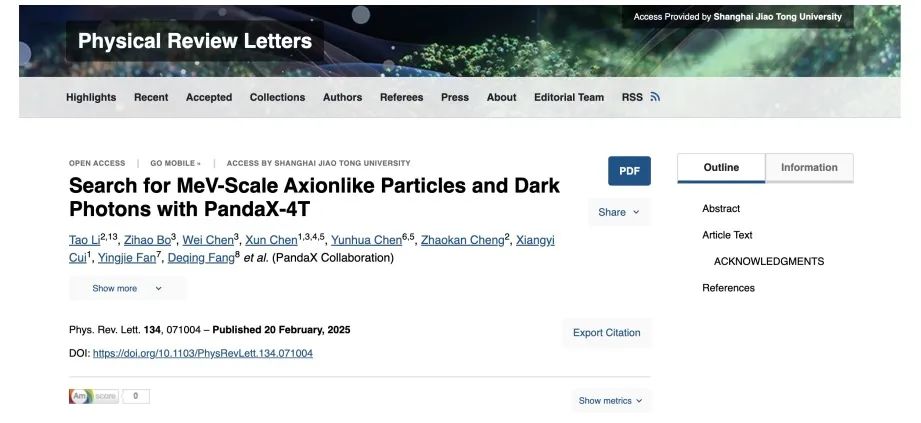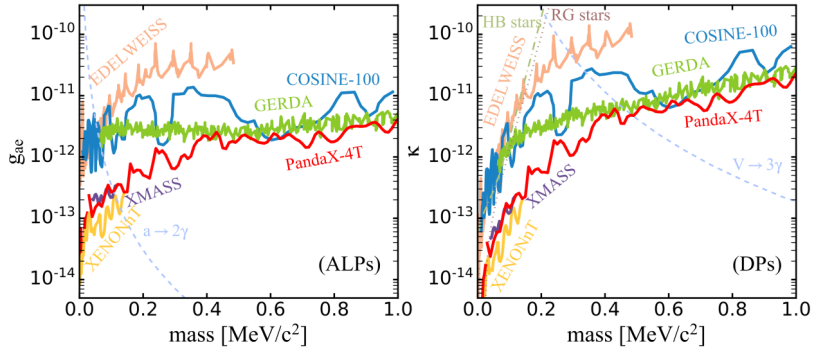
Recently, the PandaX Collaboration, led by Shanghai Jiao Tong University, utilized the PandaX-4T liquid xenon detector at the China Jinping Underground Laboratory to search for two important types of new physics particles—axion-like particles and dark photons. The team achieved the most sensitive results internationally, surpassing several competing dark matters and neutrinoless double-beta decay experiments. The research findings, titled "Search for MeV-Scale Axionlike Particles and Dark Photons with PandaX-4T," were published in the top physics journal Physical Review Letters. Shanghai Jiao Tong University is the first institution listed on the paper, with Assistant Researcher Li Tao from the SJTU Paris Elite Institute of Technology as the first author. Associate Professor Wang Shaobo from the SJTU Paris Elite Institute of Technology, Professor Han Ke from the School of Physics and Astronomy, and Associate Professor Xiao Xiang from Sun Yat-sen University are the co-corresponding authors.

Research Background
Astrophysical and cosmological observations provide solid evidence for the existence of dark matter. Axion-like particles and dark photons, as light-mass dark matter candidates, have garnered attention for their potential to resolve small-scale structure issues such as the excessive density of galactic cores. Unlike the mainstream dark matter candidate WIMP (Weakly Interacting Massive Particles), which is detected through scattering signals with nuclei or electrons, axion-like particles and dark photons can be directly detected through unique absorption signals. Analysis of the time evolution of short-lived xenon isotope backgrounds

Targeting the dark matter mass range from 30 keV/c² to 1 MeV/c², the research team systematically searched for the absorption signals of axion-like particles and dark photons interacting with electrons, based on a likelihood fit method, using 440 kg·yr of experimental data. The team was the first to analyze the time-evolving characteristics of xenon isotope backgrounds, deepening the understanding of the background model and directly enhancing the experimental sensitivity. No significant signal excess was observed in this study, leading to the most sensitive experimental constraints to date. Compared with other international liquid xenon experiments, this is the first time that the mass search range for this type of dark matter has been extended to 1 MeV/c² globally, providing important experimental constraints on heavy axion-like particles and dark photons and driving the development of liquid xenon detector technology towards higher precision, lower background, and wider energy range.

The red line represents the latest research results from the PandaX-4T experiment.
Team Introduction

王少博

李涛

黄厚齐

姚舜禹

周嘉旭
The PandaX research team at the SJTU Paris Elite Institute of Technology currently consists of five members, including Associate Professor Wang Shaobo, Assistant Researcher Li Tao, and master's students Huang Houqi, Yao Shunyu, and Zhou Jiaxu.
This research was supported by the China Jinping Underground Laboratory, as well as funding from the National Natural Science Foundation of China, the Ministry of Science and Technology, the New Foundation for Science, the Yangyang Development Fund, the Shanghai Science and Technology Commission, the China Postdoctoral Science Foundation, and the Hongkong Huiwen Foundation, among others. Currently, the PandaX-4T detector is in the process of collecting new batches of physical data and is actively advancing the development and construction of the next-generation, multi-ton liquid xenon detector to maintain China's international leading position in the field of dark matter research with large scientific facilities.







